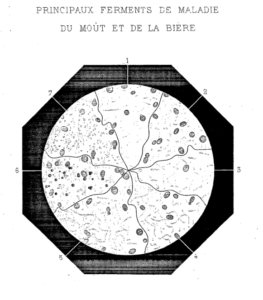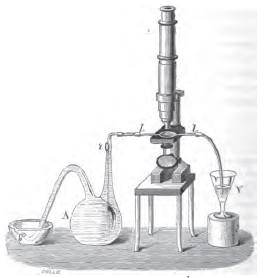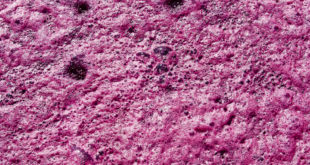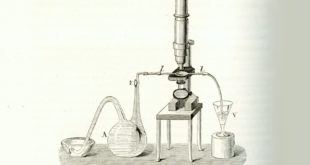This review was originally published in the Pharmaceutical Journal and Transactions, November 17, 1877, pp. 395-397.
REVIEW
Etudes sur la Bière, ses Maladies, Causes qui les Provoquent, Procédé pour la rendre inaltérable, avec une Théorie nouvelle de la Fermentation
Par M. L. Pasteur, Paris: Gauthier-Villars. 1876.
It is part of the creed of the average English beer drink, that the brewers of this country practice their art with an admitted superiority over the brewers of all other lands. Here and htere one better informed might admit that something in the way of beer brewing was done in Germany, but the popular conception of the relation of Frenchmen to the calling is manifest in the partiality of the typical Gual of the comic prints for English “portaire.” Those who share this belief may be surprised to learn that the book which is the subject of this notice is the work of a Frenchman and is one of the most important that has yet been written on beer brewing, being one which by the scientific light it throws upon difficulties that have hitherto been dealt with empirically cannot fail to exercise eventually a wide-spread influence on brewing techniques.

The readers of this Journal are not unacquainted with M. Pasteur’s views on fermentation, and in March 1874 an account was given of the manner in which he proposed to practically apply his theories in the brewing of beer. In his new volume M. Pasteur has gone into the subject more fully, and considering its importance and interest it may be desirable to recapitulate here the principal points of M. Pasteur’s arguments and observations.
It is practically admitted that there is a close connection between the keeping properties of beer wort and the finished beer in the processes adopted for their production. Thus after hte wort has been boiled it remains sound whilst at a high temperature, but when the temperature falls below 70°C, it becomes liable to lactic and butyric fermentation, and between 25° and 35°C. especially so. Hence the practice of reducing the temperature of the wort as rapidly as possible by the use of ice nad other means to a point where the wort is comparatively safe from alteration.
The changes that take place in beer are various; it may become tart, flat, putrid, ropy, or otherwise unfitted for drinking. Simultaneously with each of these changes there is a development of characteristic organisms and these, which are beautifully figured in the book (Figure 1), M. Pasteur holds to be the cause of the changes. In putrid beer the organism is a vibric, but in the other commoner varieties of deteriorated beer the organisms, although differing in each case, have more or less a filamentary outline of less diameter and are very different from the spherical granules of true beer yeast. So uniformly is this the case that the author recommends the regular use of hte microscope in a brewery, as the detection of these filamentary organisms may be taken as sure sign of actual or impending deterioration of the liquor. For this reason he terms them ferments de maladie.
As to the source of these organisms of course, M. Pasteur will not admit their spontaneous generation, neither will he admit that they are modifications of a common organism brought about by the conditions in which they are placed. But he looks upon each as a separate vegetation, the germs of which have been deposited in the liquor, or on the apparatus from the atmosphere, or directly introduced as a contamination of the yeast. But although ferments de maladie are not transformed one into another through the conditions surrounding them, these conditions exercise a selective influence on their development. Thus the spores of mucedines, and the germs of bacteria, leptotrix, vibrios, etc. may fall simultaneously into an acid liquid, such as grape must, but whilst moulds would flourish there, bacteria and vibrios would be retarded in their growth if not killed by the acidity of the liquor.
If, however, the must were previously saturated with carbonate of lime, the opposite of these conditions would obtain; bacteria, lactic ferments and butyric vibrios would invade the liquor long before the moulds had time to establish themselves, their germination being very sluggish in an alkaline or neutral liquid. When once an infusion becomes covered with one vigorous growth it does not for the time readily support another, as all the available nutriment, and especially the oxygen, are seized by the first comer. But as the special nutriment of this growth becomes exhausted from the liquor its development gradually flags, until a point is reached when it may give way to the development of a hitherto dormant ferment more suitable to the altered condition of the liquid.
This selective action of liquids M. Pasteur turns to account in the cultivation of particular ferments in suitable media, where they will grow to the exclusion of the development of any other fungi with which the original spores may be mixed. But as long as there exists the smallest admixture of a foreign ferment thee is a possibility under altered conditions of the admixture becoming the predominant growth. Thus, if beer yeast transparently pure, but containing the least trace of lactic ferment, be introduced into an alkaline mixture of milk and sugar, the fermentation that takes place is not the ordinary alcoholic fermentation but the lactic fermentation. In this way the author explains the hypothesis that has been put forward that one ferment is transformed into another by a variation of surrounding circumstances.
But although one of these fungoid growths is not transformed into another–as, for instance, the Penicillium glaucum or Aspergillus glaucus into beer yeast–some interesting facts were observed in the course of the investigation by which that result was established. When a mould that ordinarily vegetates in contact with atmospheric air, and draws from thence the oxygen necessary for its existence, is deprived of that source of supply, it may still continue to live, although with difficulty; but in this case the form of it sporic or mycelium development undergoes a change. Generally it may be stated that the tubes of the mycelium become shorter and thicker, approaching a globular form, and at the same time the plant shows a great tendency to act as an alcoholic ferment; that is to say, when plunged beneath the surface of a saccharine liquid it decomposes sugar with formation of carbonic anhydride, alcohol, and other undetermined substances, probably varying with the different moulds. The explanation give by Dr. Fitz, of Berlin, and endorsed by the author, is, that a fermentation fungus requires oxygen for its development; if it finds this in a free state it uses the oxygen in burning up a part of the sugar to assist it in assimilating another part; if there be no free oxygen the plant obtains from the sugar itself the oxygen it requires. This is in accord with what is observed in the development of even superficial beer yeast; for although it grows mos luxuriantly when freely in contact with the air, it does not induce the formation of alcohol so rapidly as a less luxuriant growth submerged beneath the surface of the liquor.

It may be remarked that, whether right or wrong, the views propounded by the author are not mere speculations, but are inferences drawn from numberless experiments, many of which are described and beautifully illustrated in the volume (Figure 2), but cannot be more than alluded to here.
The chapter on the alcoholic ferments is intensely interesting and is almost bewildering in it suggestiveness. Take beer yeast, for instance. It is usual to speak of this as of two kinds–superficial yeast and bottom yeast; the form being almost exclusively used in this country and the latter on the continent. By some these two have been looked upon as two forms of one ferment, modified by its development, in the once case submerged in the liquor at the bottom of the vat, and in the other by its development at the surface of the liquor in the presence of atmospheric air. But M. Pasteur is evidently doubtful of this. In fact he quotes evidence to show that each may be a mixture of several distinct fermenta. Thus, superficial yeast, obtained absolutely pure by cultivation, is killed by a temperature of 50°C., and is no longer capable of provoking fermentation. But one commercial sample of superficial yeast submitted to that temperature still remained capable of producing fermentation, due to the survival of a previously unnoticed form, to which in consequence of its physical appearance the name of levre caséeuse has been given. This ferment was afterwards separated in the same way from other samples of superficial yeast, and further investigation and comparison led the author to believe that this hitherto unnoticed yeast plays an important rôle in some breweries, especially in the production of the famous pale ales manufactured at Burton-on-Trent by Messrs. Bass and Allsopp! Another superficial ferment accidentally met with was cultivated and yielded a beer unlike any at present known. More over all these forms can, by a special treatment, be made to undergo modifications; the products can in their turn be modified indefinitely; and each is said then to yield its special beer, the aroma of which in cases is easily distinguishable.
It has been attributed to M. Pasteur that in his opposition to the theory of spontaneous generation, and also of the transmutation of species, he has accounted for the setting up of fermentation in fermentescible liquids, by supposing the air everywhere to be full of germs of all kinds of ferments, which are deposited on the surface of any such liquid whenever exposed. This, however is not in accord with the result of M. Pasteur’s experiments, for they went to show that although such germs do exist in suspension in the air, they are relatively few in number, except in localities where fermentation operations are carried on. The question therefore arises, whence do these remarkable bodies, such as the vinous ferment, take their origin? It has been found that the juice of a crushed grapes does not ferment if it be preserved form contact with the powder occurring on the skin of the grape or on the wood of the vine; whistle the powder from a single cluster or even a single grape, is sufficient to set a whole vat of juice into fermentation. This powder, collected by washing twelve grapes successively in 3 c.c. of water, was sufficient to render the water turbid, and when examined under the microscope was seen to consist of small organized bodies, associated occasionally with crystalline needles. A still larger relative quantity was obtained by washing the wood of the peduncle, and the washing of gooseberries, plums, peas, etc., gave similar results. The liquor so obtained when added to grape juice previously boiled, induced fermentation under conditions that led the author to the conclusion that the yeast cells have their origin in small brown organized bodies, which can be seen in great abundance by the aid of the microscope in the powder that covers the surface of fruits. Other experiments indicated that these bodies are only met with about the time of maturity of the fruit, and that they disappear during the winter.
The foregoing may explain the origin of ferments which cause what may be called spontaneous fermentation, such as the fermentation of wine, where the process of crushing the grapes impregnates the juice with so many of these germs that it is left to ferment without further treatment. The case is different, however, with the fermentation of beer, where the material for inducing fermentation has to be added in the form of beer yeast. Where the yeast for the first brewing came from, and whether it was superficial or bottom yeast, is an open question. As a matter of fact, beer wort abandoned to spontaneous fermentation may yield yeasts akin to that of the vine, but never the true beer yeast of either kind. Whether the ears of corn in it primeval wild form were covered by their appropriate organized pulverulent ferment, or whether beer yeast has been derived from another source and has become modified by prolonged cultivation in a particular manner, cannot now be decided.
Long as this notice has become only a few of the top topics discussed in M. Pasteur’s book have been alluded to. It will be seen, however, that it is not a book for criticism, the author’s statements being supported by a plethora of experimental results that would have to be disproved before his inferences could be well impugned. The subject is one of extremely wide interest. The practical result of the author’s researches, however, specially set forth in the present work is, that, by the proper cultivation of beer yeast in suitable media, the so-called ferments de maladie can be eliminated, and with the pure yeast so obtained beer, or beers, can be prepared that will remain perfectly unalterable. How this is to be done is too long a story to be transferred to these pages, but must be read in M. Pasteur’s handsome volume, which promises to inaugurate a new era in the history of beer brewing.
 Pasteur Brewing Louis Pasteur – Science, Health, and Brewing
Pasteur Brewing Louis Pasteur – Science, Health, and Brewing 


